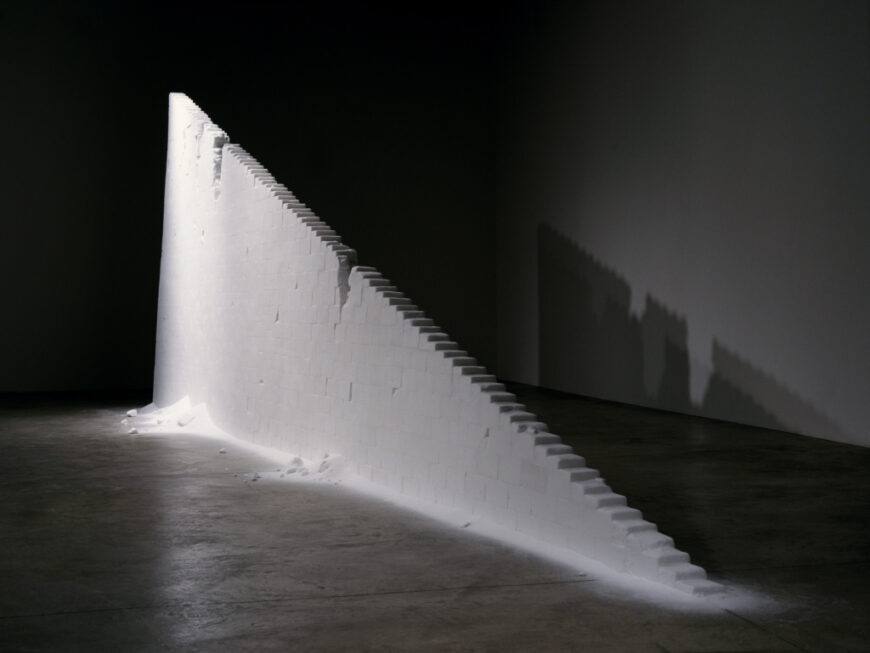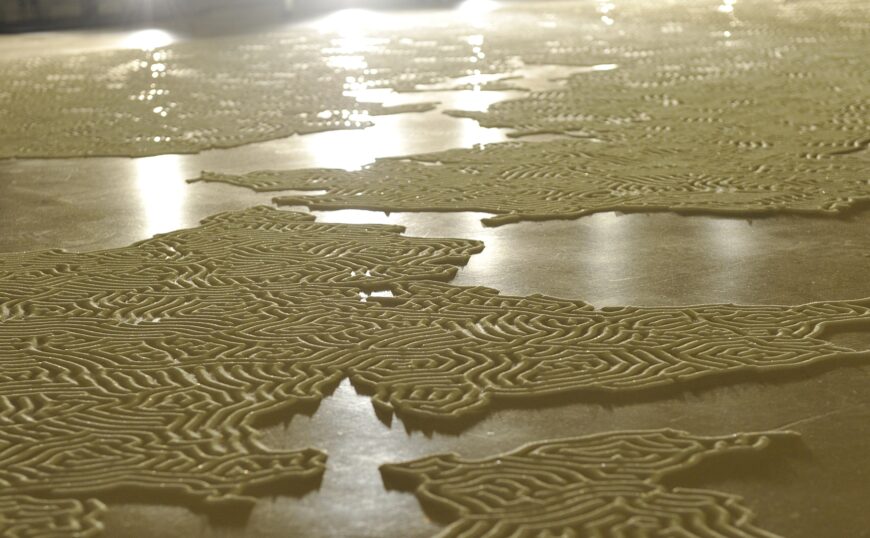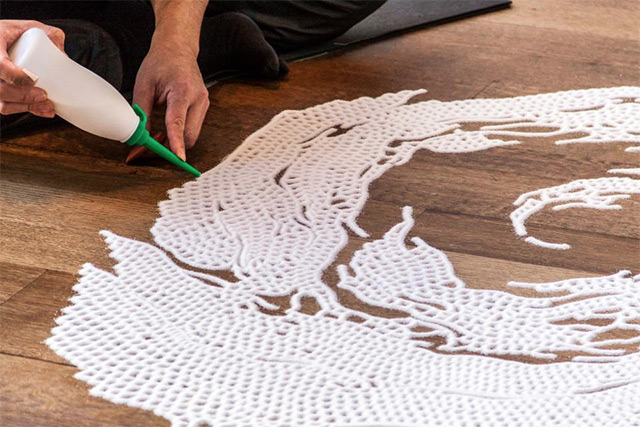
Motoi Yamamoto, Floating Garden, 2013, salt, installed at The Mint Museum (photo: James Martin) © Motoi Yamamoto
An immaculate white vortex covers the entire gallery floor. A lace-like pattern with countless pores intermingles with supple lines. Seen from above, the enormous spiral, appearing a seamless whole, recalls many natural forms: a moving typhoon, nebulae, aerial views of geographical boundaries, and receding foamy seawater on a beach. Seen up close, however, the material used to make the pattern becomes visible: the entire image is made of salt. Made in 2013, it is one work from the series of salt constructions by the Japanese artist Motoi Yamamoto called Floating Garden.
Salt and grief
Born in Onomichi in Japan, Yamamoto is currently based in Kanazawa, where he was also trained as an artist. His work of the last three decades is rooted in a personal encounter with intense grief. The loss of his beloved younger sister to brain cancer in 1994 marked a turning point in Yamamoto’s rising career as a painter, when he turned to salt as his primary material to address birth, life, death, and memory.

Motoi Yamamoto, Utsusemi, salt, installed at the 2003 exhibition, “The First Steps; Emerging Artist from Japan,” MoMA P.S.1, New York (photo) © Motoi Yamamoto
The floor installations in salt began in 1996. In that first phase, the artist constructed architectural fragments that led nowehere: life-size tunnels that disappeared around a curve, and staircases, such as Utsusemi from 2003, which ended abruptly. In 2006, such vertical structures gave way to Labyrinth, massive drawings on the floor of dizzyingly complex site-specific mazes built by meticulously pouring salt with stunning skill and patience.

Motoi Yamamoto, Labyrinth, salt, installed in Paris, 2014 (photo: Rog01, CC BY-NC-ND 2.0) © Motoi Yamamoto
The third phase emerged in 2013, when the rectilinear mazes became the fluid, organic lacework of Floating Garden. Each image of this series is shaped through several weeks of work. Yamamoto first sketches a pattern and scans it to produce a digital version of the image. It is then overlaid on a digital floor plan and adjusted to fit the space. Once the final design is drawn at the site, the artist sits on the floor, and working alone, renders the image with refined sea salt squeezed out of a nozzle, much like icing a cake. Despite the prior digital planning, the three-dimensional drawing changes as the work progresses in order to accommodate variations on the floor. A platform is often constructed in the gallery for an elevated view of a Labyrinth or a Floating Garden image.

Motoi Yamamoto, Floating Garden, 2013, salt, installed at The Mint Museum (photo: James Martin) © Motoi Yamamoto
When a common substance like salt is repeatedly used to make art, there is a risk of the artwork eventually turning into mere novelty. Yamamoto’s material and all aspects of his process, however, are grounded in profound ideas that subsume the impact of both his skill and technique, ensuring the gravity of each project.
Aside from its critical function in human and animal bodies, salt extracted from nature returns to it in various ways. What is more, it has a crucial role in Japanese culture, as an agent of purification offered at ancestral shrines, funerals, and sumo wrestling matches. To Yamamoto, salt represents the cycle of nature and continuity of culture. While he used bricks of salt to build the tunnels and stairs of the first phase, his focus later shifted to salt’s granular property. He was drawn to the symbolic potential of the resemblance of a grain of salt to the shape of the human brain and to the contrast between the translucency of individual grains and their collective opacity. He also sees the whiteness of salt as symbolic of purity and loss, triggering memories of his sister.

Motoi Yamamoto, Floating Garden, 2013, salt, installed at The Mint Museum (photo: James Martin) © Motoi Yamamoto
Salt and memory
Each grain of salt is a moment in Yamamoto’s memory, and the act of painstakingly producing an image is his engagement with the ephemerality of memory. He initially borrowed the idea of the labyrinth from European histories and myths to represent a holistic notion of memory: visually pairing the seemingly endless turns of the labyrinth was his personal journey and his hopes of “encountering” his sister. But the labyrinth motif eventually seemed inadequate because while the mazes often brought a journey back to the beginning, Yamamoto wanted to experience memory as fleeting but precious. He therefore explored his Japanese heritage to invent the more organic Floating Garden. In this series, the floor becomes powerfully evocative of the earth’s surface, where the majestic vortex symbolizes life, death, and resurrection. Its dynamism can be regarded as both centrifugal and centripetal, and its countless pores serve as bubbles representing memories of mundane moments. Especially since the passing of his wife in 2016, engagement with this pictorial strategy has allowed Yamamoto to cherish the fragments of memory while accepting its fragility.
Yamamoto does not employ assistants because for him, the rigor of his production is an exclusively personal endeavor. His process, in fact, is reminiscent of such practices as the Tibetan tradition of mandala painting with colored sand, where the visible role of a painstaking process only serves a spiritual goal. Because the intense labor, which often demands ten hours of work in a day, requires the fitness of an athlete, he sees the discipline of maintaining his body as an extension of his work. However, while Yamamoto recognizes the performative character of his meditative process, he does not want to present it as performance. Instead, a more potent form of performance is reserved for the end of a show. Since one of his goals is to translate his personal grief into a broader human experience, the artist invites visitors to scoop up the salt from an impeccably executed piece and take it back to the sea. He claims, not unlike Tibetan sand painting, that this intervention underscores the finiteness of life in the face of the ongoing cycle of birth and death.
Empowered by the profound existential questions explored by the artist, the crystalline mineral is elevated to the status of a creative agent in the connection between life and death when exhibition visitors return the substance to its natural source. And from its inception to its erasure, an entire project is thoroughly documented. Despite his respect for the transience of life and the inevitability of the loss of memory, Motoi Yamamoto ironically relies on documentation to memorize his interaction with memory.
Additional resources
Watch “Motoi Yamamoto, Labyrinth” from the State Hermitage Museum

